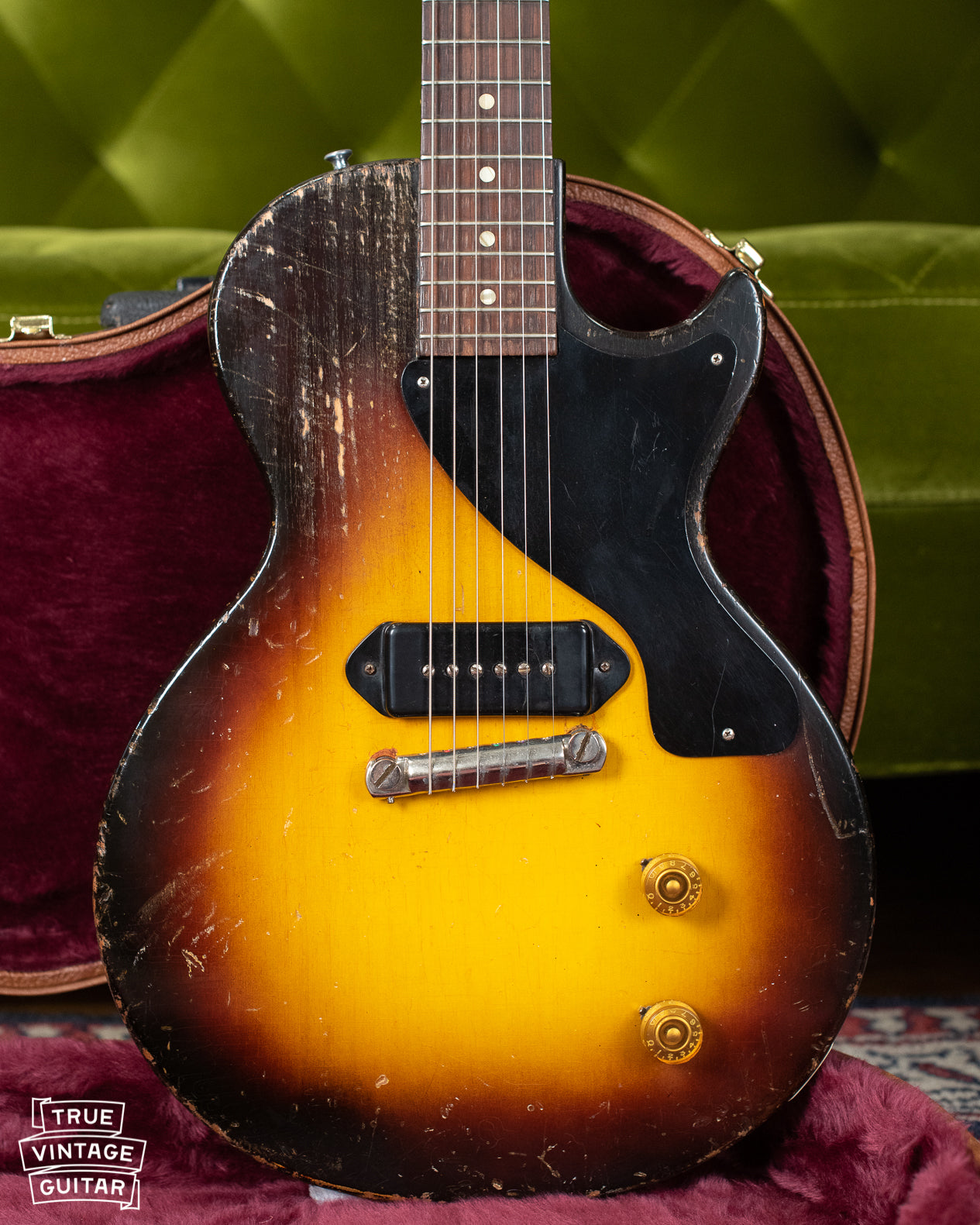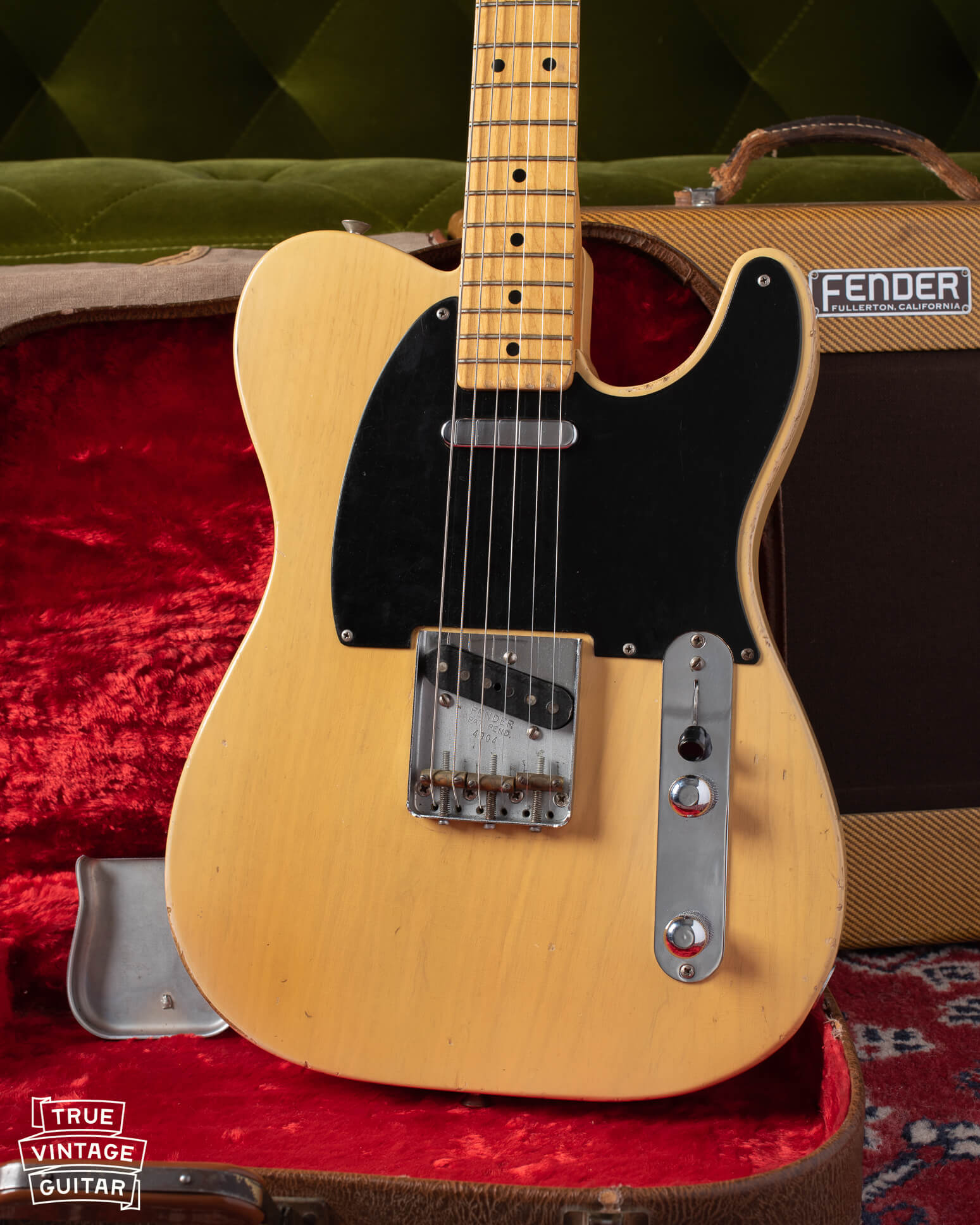This amazing vintage guitar has just come through the shop: a 1953 Fender Esquire in original Blonde finish with black pickguard that was found in a barn in Florida only a few months ago! While it did have some various changed parts and a dead pickup when it came in, it became a really great playing example with a little tender loving care. While the Esquire models are only one pickup away from being a Telecaster, it feels like playing a completely different guitar and changes the way I play.
At True Vintage Guitar, we appraise and buy high end vintage collectible guitars made in the 1950s and 1960s by Fender and Gibson. This 1953 Fender Esquire is an excellent example of the guitars we work with and how we can serve people selling a vintage guitar. If you're looking for help with a vintage Esquire or Telecaster, check out How to date a Telecaster. Or if you're looking for help finding the year of an old Fender guitar by serial number, check out Fender Serial Numbers.

1953 Fender Esquire Found in a Barn?
No, really! I received a call from the seller of this 1953 Fender Esquire a few months ago. He had a job helping to clean out a local property in northern Florida whose previous owner had passed away. The payment for the job included an hourly wage plus anything he found on the property he could keep. Can you imagine walking into a derelict barn and finding a 1953 Fender Esquire hanging on the wall?
He was able to keep the '53 Esquire as part of the payment for such a large job, but he wasn't a guitar collector. He reached out to me for help identifying the year it was made, the model, and what it could be worth. When I saw the thin Blonde finish, the black pickguard, and the single pickup, I knew it had to be an early 1950s Fender Esquire. He sent a picture of the serial number located on the bridge plate which showed four digits in the 4000 range. It's important to remember that Fender serial numbers are not necessarily sequential and can be misleading when dating an old Fender. However, all the externally visible features supported a 1953 manufacturing year.

The seller and I discussed how the Esquire is similar to the Telecaster but not the same thing. Fender's Esquire debuted in 1950 before even the Broadcaster, but it had two pickups at its introduction. Once the Broadcaster was introduced in October of 1950, the Esquire model became the single pickup version which was slightly less expensive. The Esquire continued on even after the Broadcaster name was replaced by the Telecaster until production ceased in 1969. While Esquires are less common than Telecasters, they're not quite as valuable because of both name recognition and the lack of the versatility from the second pickup.
I was please to be the high bidder to purchase this Esquire and was excited to inspect it inside and out. The neck heel has the classic "TG" initials for the now famous Fender employee Tadeo Gomez. The neck was roughly shaped on February 16th, 1953, but it likely wasn't finished until a month or two later. It's also important to note that Tadeo was a foreman at the factory during this time, not the employee who shaped the neck. Mr. Gomez likely only signed off on the neck instead of being the one who shaped it himself.


Restoring the 1953 Fender Esquire to original playability
The most significant problem it had was that the pickup was dead. Fender pickups can die but still make sound when plugged into an amplifier. That was the case with the pickup on this Esquire, but the multimeter doesn't lie. When we measure the resistance of a Telecaster or Esquire bridge pickup, we're looking for something in the range of 5k to 7k ohms, but this pickup was reading 160k ohms. You can also hear a dead pickup if it lacks rich fullness and bass response. Dead pickups will either make no sound or will sound thin and a bit harsh. I sent off the pickup to Tom Brantley who rewound it to factory spec.

Did you notice how Fender Esquires have a three position switch, but only one pickup? The Esquires three positions include: all the way back is the pickup and volume potentiometer, middle position incorporates the preset tone knob, and the forward position is for "deep soft rhythm". This may also have been used to mimic a bass guitar (since the electric bass was not yet widely available in 1950 when this sound was developed). This 1953 Fender Esquire had a couple of the capacitors replaced in the control panel, but they appeared to be the correct value. I left them as-is.

The rest of the cleaning and set up on the Esquire was pretty straight forward. It's always a delicate balance between cleaning off caked off dirt and grime and preserving the original patina. This one came out great with all its original Blonde finish that's thin and flakey. The thin and flakey finish is a feature of the Fender guitars made in the original factory before the move to the new factory in mid 1953. You can see an example of the smoother late '53 finish on this 1953 Fender Telecaster.
Selling an Early 1950s Fender Esquire, Telecaster, or Broadcaster?
At True Vintage Guitar, we appraise, buy, and sell high end vintage guitars from Fender and Gibson made in the 1950s and 1960s exclusively. Our goal is to help sellers accurately identify the year/make/model, use actual comparable sales to help establish its value, and to be their highest offer to sell their guitar. This 1953 Fender Esquire is an excellent example of the guitars we help with, but we also work with Broadcaster and Telecaster guitars from the 50s and 60s.
If you're looking for help finding the year of a vintage Fender then check out Fender Serial Numbers
Or you can get an appraisal for your vintage Fender guitar here: Guitar Appraisal.
You can contact us to sell a vintage Fender guitar here: Sell a Fender




